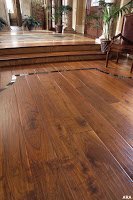How to Install Wide Plank Wood Floors over Concrete
 Wood over concrete? Yes, it can be done! For the longest time, homeowners were warned that wide plank wood floors installed over concrete would result in moisture problems. But that’s not so anymore. A concrete sub-floor is no reason to deny yourself beautiful wood floors. Nowadays, they can go virtually anywhere.
Wood over concrete? Yes, it can be done! For the longest time, homeowners were warned that wide plank wood floors installed over concrete would result in moisture problems. But that’s not so anymore. A concrete sub-floor is no reason to deny yourself beautiful wood floors. Nowadays, they can go virtually anywhere.
It is true that wood is affected by climate change: wood fibers expand and contract with fluctuations in relative humidity. However, this movement and the resulting moisture problems can be controlled with proper installation techniques and the use of high quality wood products. “If you’re going to be installing over concrete, it becomes even more critical that you understand what part of the tree the boards are cut from and the manner in which the boards were processed; both of these factors are vital to your overall satisfaction with the floor,” says Chris Sy from Carlisle Wide Plank Flooring. He explains that wood cut from the center of a tree contains a higher percentage of vertical grain which makes it less susceptible to movement and thus a higher quality material.
Before you embark on this installation process, Carlisle recommends certain rules of thumb to manage moisture and ensure the stability of the wood:
- Be sure the wood supplier has properly dried the wood. (Carlisle recommends 12 month air drying.)
- Let the wood acclimate in the home or business for 24 hours.
- During acclimation in your home or business, keep relative humidity at 45 percent.
- Make sure the wood flooring has proper stress reliefs. (These ridges on the underside of the wood relieve tension in wood, reduce board movement, and provide a greater glue surface.)
Here are some step-by-step installation guidelines once you know the height allowance:
Option One: Gluing directly to concrete -- 1/2 to 3/4 inch height allowance
Using either Bostik’s Best or Sika adhesive product, spread one layer of adhesive onto the concrete per manufacturer’s instructions and place your Carlisle planks, milled to 1/2 to 3/4 inch thickness directly onto the adhesive. Allow 12 hours drying time before finishing your floors.
Option Two-A: Concrete slab with plywood sub-floor -- 1 inch height allowance
Place a layer of 6mm polyethylene onto the concrete as your moisture barrier. Using a Hilti Direct fastening tool, shoot concrete nails into 1/2 inch plywood to apply directly onto concrete. Install Carlisle Wide Plank Floors, milled to 1/2 inch thickness by blind nailing and gluing.
Option Two-B: Concrete slab with plywood sub-floor --1 1/2 inches or more height allowance
Lay down 3/4 inch plywood and then follow the directions above.
The cost associated with both options for installing wood over concrete is similar. However, due to the cost of the adhesives, it can be slightly cheaper to use the plywood method.
It’s also possible to install Carlisle floors over concrete slabs with radiant heat. The installation process calls for using a floating plywood sub-floor.
Proof that this method of installation has gained industry acceptance is its prevalence in high end commercial applications. For instance, the Park Hyatt Hotel in Washington, D.C., used Carlisle White Oak wide plank wood flooring over concrete in the public space of their main level. Given the resources for high quality wood, like Carlisle Wide Plank Floors, and the variety of mastic adhesives available today, you too can install wood floors over concrete in your home.
For more information about Carlisle floors, or to access their step-by-step instruction book for more specific directions, log on to www.wideplankflooring.com or call (800) 595-9663.
Courtesy of ARAcontent

No comments:
Post a Comment